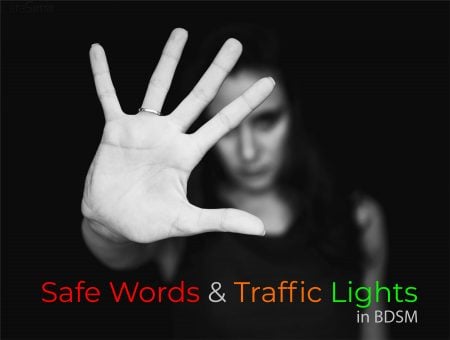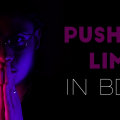Safe Words And Traffic Lights: How To Say Stop In BDSM
During your explorations of the BDSM world, you may have come across the terms safewords and traffic lights. What are BDSM safe words, and what do traffic lights have to do with the exciting world of power exchange, kink and fetish?
What Are BDSM Safe Words? Who Are They For?
What exactly is a BDSM safe word? It’s a word you agree upon with your sex or play partner which will mean no or stop. It’s a word you wouldn’t usually say as part of sex or BDSM, therefore the words ‘no’ and ‘stop’ need replacing with something else. Something unusual, and which can immediately be identified as genuinely meaning the person wants proceedings to stop immediately. We tend to use “lemmings” or “giraffe” or “orange”, for example.
Don’t assume a safeword can or should only be used by the submissive person or the one in the bottom role. Safe words can be used by anyone at any time during sex and BDSM, and they should of course be respected by everyone involved.
When To Use Safewords
Don’t ever be afraid to use, or cautious about using, your safe word. BDSM safewords are set before the action starts so that you and your partner feel safe, and safe to continue, at all times. If you’re thinking “oh, maybe I should safe out of this by saying my safeword” then say it.
Or, you can use the traffic lights method below (or a combination or BDSM safe words and traffic lights) and say “amber” (or “yellow”) to stop temporarily & discuss or “red” in place of “completely stop immediately”. Let’s look at BDSM traffic lights in more detail.
What Are Traffic Lights In BDSM?
As briefly touched on above, BDSM traffic lights are basically what you’d imagine them to be. The colours of traffic lights are used as an effective method of communicating how you really feel about what’s going on at the time, during sex and/or BDSM sessions.
Here’s a brief explanation:
“Green” confirms you’re OK to continue, everything’s good.
“Amber” or “Yellow” indicates that you’re nearing your limits and/or you need to stop temporarily to discuss how to proceed in a more comfortable way.
“Red” is a clear communication to stop immediately.
What About When You Can’t Talk?
At times during BDSM sessions, or during bedroom bondage and sex, you might not be able to say your safe word. BDSM gear such as ball gags and other mouth gags, bondage hoods and masks, or other devices may remove your ability to speak. How are you supposed to convey ongoing active consent or that you need the session to stop immediately, if you can’t use BDSM safe words?
If you or your play partner are consensually tongue-tied by the use of one of the above bondage toys or other, make sure you agree on another method of safing out before you start. This could be by finger signals –if their hands aren’t tied, of course. This depends on the Top/one in control keeping an eye on the bottom/submissive’s hands so they don’t miss the signal.
A more reliable method of non-verbal safing out is by giving them a buzzer or other audible button to press, or a bell to ring.
Staying Safe: Trust, Respect & Active Consent
At the heart of all good and enjoyable sex and BDSM are the above tenets: trust, respect and active consent. Consent is a non-negotiable, mandatory aspect. Therefore, you have to be sure everyone involved is actively consenting to proceedings at all stages throughout the sex or power exchange play session.
BDSM safe words and safing out methods are a good indication of how someone really feels, in a situation where yelps of “no” and “stop” might simply be part of the consensually kinky soundtrack. Don’t be afraid of using, or too proud to use your safe words and safe out methods. Safing out or using BDSM traffic lights isn’t weakness, it’s communication! Everyone has their limits –yes, everyone.
I believe BDSM safe words and mutually agreed safing out methods are a requirement for both sexual and non-sexual kinky and power exchange sessions, not merely an option. Hopefully this article has helped explain both what safewords are as well as how and when to use yours.

Contains affiliate links








































Requirement.
I know someone who is just getting into being tied up and giving her partner full on control of her pleasure, and the first thing I told her was ALWAYS have a safe word, then going on about the traffic light system. I’m thankful that while I have a safeword with my Mr, He always knows when I am feeling hesitant or need to stop without the use of it.
I could never submit to someone who does not use safewords, I wouldn’t be able to trust them.
I’d call it a requirement as well. I’m not even all that kinky, and I like having a safe word just in case. It gives me peace of mind that – no matter what my fiance and I choose to explore – it won’t go too far. It’s nice that it’s there.
[…] but rather as an umbrella term for anything that could be described as being part of BDSM. (Read more … […]
I brought a friend recently to a fetish party. She is a sub, but completely new to the scene. I played with her and could tell her pain threshold was low so I took it slow. She ended up playing with a male friend of mine, and I was worried for her because he seemed to be going very intense on her. I found out after that he had told her at the start not to say “red” because the people managing the party would rush in and throw him out. I think it is completely irresponsible to try to discourage from using safety words. That party has rules about the traffic light system for a reason. She also said “almost yellow” and he questioned her on that. This is one of her first times playing ever, and it is best to not go too hard, or we may lose someone who could of loved this scene because one bad apple scared her off.
For me and my wife it is also a requirement. We’re both just testing out and “playing” in the truliest meaning of the word. And therefore it is a real calming to know that both of us is at anytime able to break the position we put ourselves in without doing any harm. The traffic lights are very appreciated as well.
I agree I think it should be a basic rule during BDSM Especially as it means then everyone is kept safe.
I posted about safewords this month as well! =) Such an important topic.
In my relationship, safewords are also a requirement. I feel that it truly brings a deeper level of consent and communication during sexual play of all kinds.
Thanks for all your comments and reading my article. It’s such an important area – and yes I feel it’s a requirement too.
Thanks again everyone x
Requirement! And this point “Submissives would also do well to remember that not using a safeword when it’s required isn’t a point of pride, it’s putting yourself at risk.” and also putting your partner at risk. I couldn’t agree more with this statement and I truly hate the ‘oh but my Master/Dom etc is so in tune with me that I don’t need one’. Personally I think my husband is about as in tune with me as it is possible to be with another human being, but that still doesn’t mean he is inside my head or my body and can truly understand how I am experiencing something and nor would he ever claim to be.
Mollyxxx
I also just wrote about this a week ago 🙂 Funny how life goes!
[…] of Glass Talking BDSM: Are safewords really necessary? 45 Seconds I want Whispered Words Aftercare: In Kink and Erotica Ariel Castro: The Man in the […]